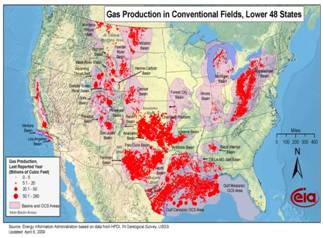Making A Big Production: Shale’s Growing Share of US Natural Gas Resource Base
Prior to the arrival of shale gas, estimates of the amount of natural gas in the United States grew steadily, but in relatively small increments. Because of developments in horizontal drilling and hydraulic fracturing, improvements in the ability to economically recover natural gas from shale rock changed that pattern, bringing about an unprecedented 39 percent increase in the amount of recoverable natural gas in the United States between 2006 and 2008.
In 2011, the U.S. Potential Gas Committee, a nonprofit organization of highly experienced industry experts, reported that the U.S. possesses a total natural gas resource base of 2,170 trillion cubic feet (Tcf), the highest resource evaluation in the committee’s 46- year history. The study estimated that the U.S. has a 100-year supply of natural gas and announced that shale, an “unconventional” gas resource that was barely a blip in previous assessments, now accounted for approximately one-third of the total resource base.
 |
Other estimates also attest to the remarkable growth of the resource base. In 2011, the Energy Information Administration (EIA) estimated that U.S. shale plays contain 827 Tcf of recoverable natural gas. By 2035, the EIA estimates that shale gas production (12.2 Tcf) will represent 47% of U.S. production.
Estimates of the size of the natural gas resource base are dynamic and reflect ongoing progress in science and technology, explaining why the estimated size of the U.S. natural gas resource base has continued to grow over the years even as natural gas is produced and consumed. For example, since 1998, the EIA’s Annual Energy Outlook forecasts of unconventional gas production have been significantly outstripped by actual production levels.
In the seven most active shale plays producer estimates acknowledge that the potential production level could reach as high as 30 billion cubic feet (Bcf) per day by 2020. In the Barnett Shale, for example, production has grown from 94 MMcf/day in 1998 to 3,014 MMcf/day in 2007, an increase of more than 3,000 percent in the span of nine years. Nearly 10 percent of all US shale production originates from the Barnett Shale.